
Date: July 5, 2021
Location: Lat: 32.92230°, Lon: -54.913995°
Dive depth range: 2,562 - 2,815 meters (8,406 - 9,236 feet)
Access Dive Summary and ROV Data
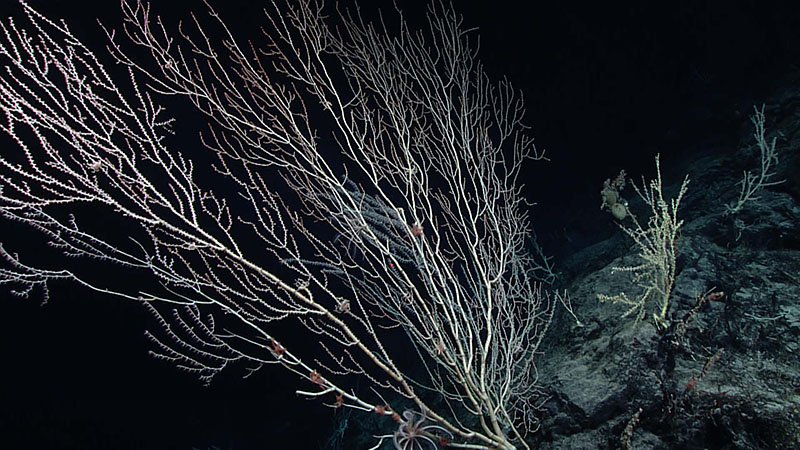
Bamboo corals (family Isididae) were the most frequently observed corals throughout the second dive of the 2021 North Atlantic Stepping Stones expedition. This particular colony, seen at 2,605 meters (8,547 feet) depth, measured nearly 2 meters (6.5 feet) tall! Image courtesy of NOAA Ocean Exploration, 2021 North Atlantic Stepping Stones: New England and Corner Rise Seamounts. Download largest version (jpg, 1.2 MB).
During the second dive of the 2021 North Atlantic Stepping Stones expedition, we explored along the east side of the south peak of Congress Seamount, about 530 miles east of Bermuda. As virtually no prior exploration had taken place on this seamount, the primary objectives of the dive were to explore and characterize ecological conditions and geological features of the seamount, to help scientists establish the relationship between this seamount and the nearby New England and Corner Rise seamount chains.
While the density of coral on the dive was often high, particularly as we moved closer to the seamount summit, the diversity was low. Coral and sponge communities were found in patches, alongside large aggregations of broken coral branches and dead stalks covered in ferromanganese crusts. Other animals observed included a few fish, molluscs, brittle stars, brisingid sea stars, and one sea spider (pycnogonid).
During the first half of the dive, we traversed a mix of rock debris and in situ slopes, with thin sediment accumulations, indicating a geologically dynamic environment. As we moved towards the summit of the seamount, the seafloor changed markedly to sediment-free, sheet-flow formations and steeper, rugged outcrops that at times appeared to display pillow lava-like textures. Some thick sediment accumulations were seen near the summit.
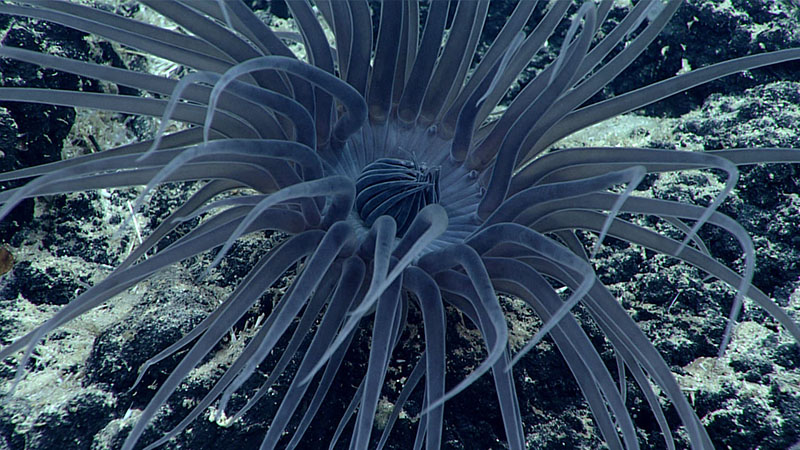
This beautiful sea anemone was seen during Dive 02 of the 2021 North Atlantic Stepping Stones expedition. Very little is known about this animal—it is likely an unknown species, genus, and even family. It is believed to have been seen once before on a NOAA Ocean Exploration expedition on NOAA Ship Okeanos Explorer, but in the Pacific Ocean. Image courtesy of NOAA Ocean Exploration, 2021 North Atlantic Stepping Stones: New England and Corner Rise Seamounts. Download largest version (jpg, 1.2 MB).

This colony of yellow zoanthid polyps overgrowing a bamboo coral skeleton was seen at 2,775 meters (9,104 feet) depth on Congress Seamount during the second dive of the 2021 North Atlantic Stepping Stones expedition. Zoanthids, which are cnidarians belonging to the order Zoanthidea, were quite common throughout the dive. Many zoanthids, like those seen here, are epizoic, meaning they prefer to grow on other animals such as sponges and corals. Image courtesy of NOAA Ocean Exploration, 2021 North Atlantic Stepping Stones: New England and Corner Rise Seamounts. Download largest version (jpg, 1 MB).

A mixture of pillow lava-like outcrops and blocky rock debris were seen for much of Dive 02 of the 2021 North Atlantic Stepping Stones expedition. In this image, remotely operated vehicle Deep Discoverer traverses over an apron of rock debris. Sediment cover here was thin and primarily limited to spaces between rocks, suggesting a geologically dynamic environment. Image courtesy of NOAA Ocean Exploration, 2021 North Atlantic Stepping Stones: New England and Corner Rise Seamounts. Download largest version (jpg, 429 KB).
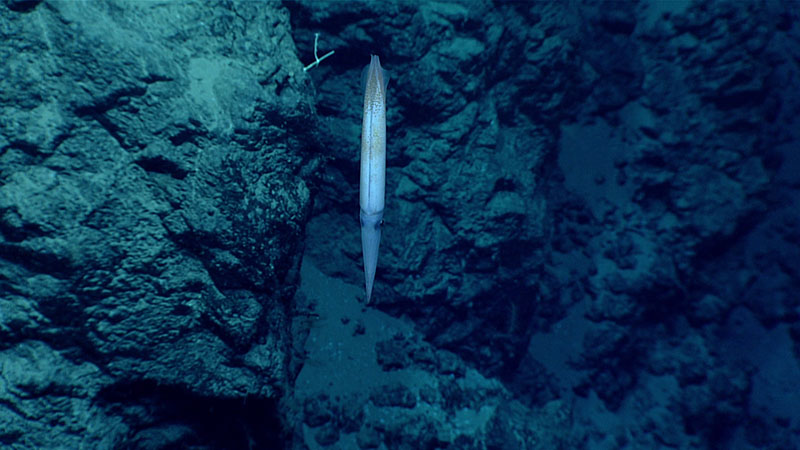
Within a few minutes after reaching the seafloor at the start of Dive 02 of the 2021 North Atlantic Stepping Stones expedition, we imagined this small squid. Members of our on-shore science team suggested that the squid may have been a juvenile giant squid (Architeuthis sp.)! Image courtesy of NOAA Ocean Exploration, 2021 North Atlantic Stepping Stones: New England and Corner Rise Seamounts. Download largest version (jpg, 836 KB).
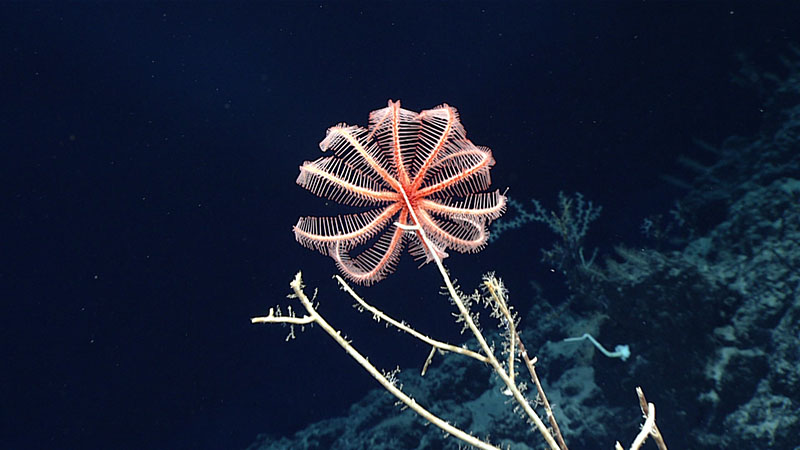
A beautiful brisingid sea star sits at the very top of a bamboo coral, taking advantage of the perch off the seafloor for better feeding opportunities. Note that much of the bamboo coral is stripped of its polyps. Early in the dive, this was typical, with nearly all bamboo corals being at least 50% denuded, though no obvious coral predator was found during the dive. Image courtesy of NOAA Ocean Exploration, 2021 North Atlantic Stepping Stones: New England and Corner Rise Seamounts. Download largest version (jpg, 775 KB).
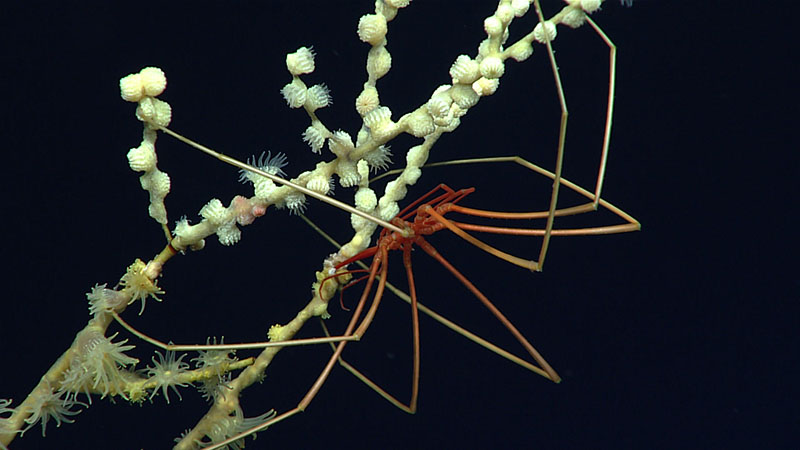
This sea spider, or pycnogonid, was observed crawling up a colony of bamboo coral overgrown by yellow zoanthids during Dive 02 of the 2021 North Atlantic Stepping Stones expedition at 2,623 meters (8,605 feet) depth. Image courtesy of NOAA Ocean Exploration, 2021 North Atlantic Stepping Stones: New England and Corner Rise Seamounts. Download largest version (jpg, 662 KB).
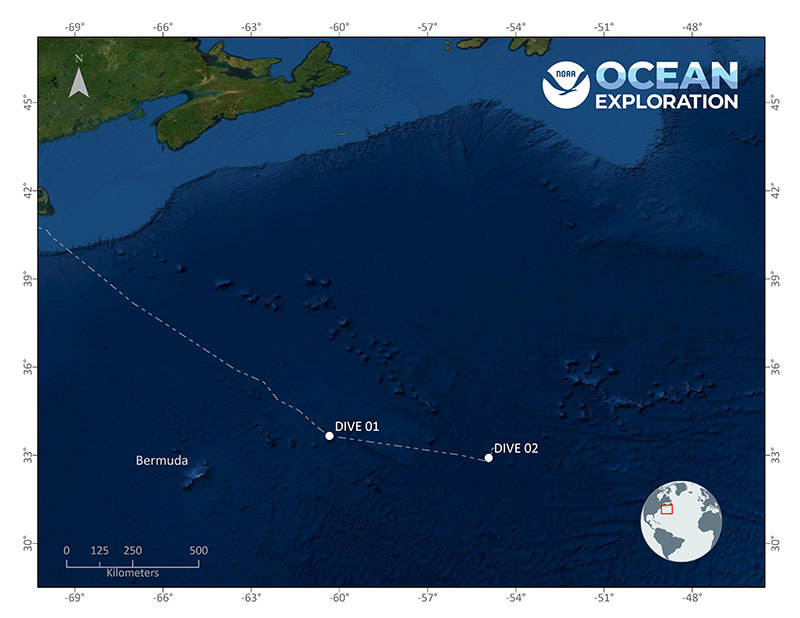
Location of Dive 02 of the 2021 North Atlantic Stepping Stones expedition on July 5, 2021. Map courtesy of NOAA Ocean Exploration, 2021 North Atlantic Stepping Stones: New England and Corner Rise Seamounts. Download largest version (jpg, 2.4 MB).
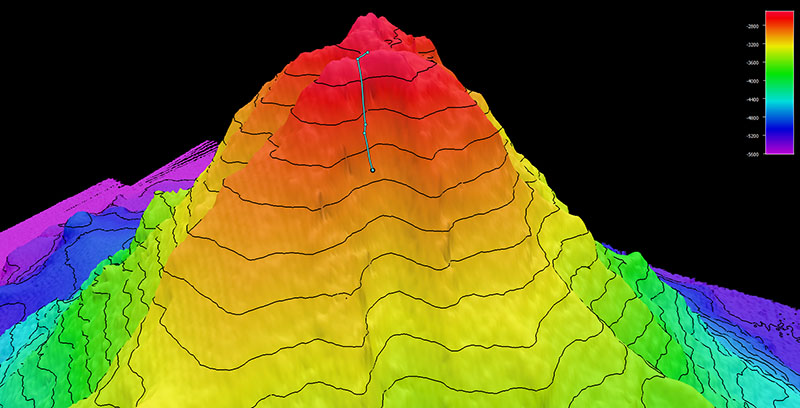
Image showing the dive track of Dive 02 of the 2021 North Atlantic Stepping Stones expedition. Scale is water depth in meters. Image courtesy of NOAA Ocean Exploration, 2021 North Atlantic Stepping Stones: New England and Corner Rise Seamounts. Download largest version (jpg, 768 KB).